
|
February 2010
|
|
|
The U.S. Department of Energy's Thomas Jefferson National Accelerator Facility
|
|
Detector Group Builds SPECT Camera for
|
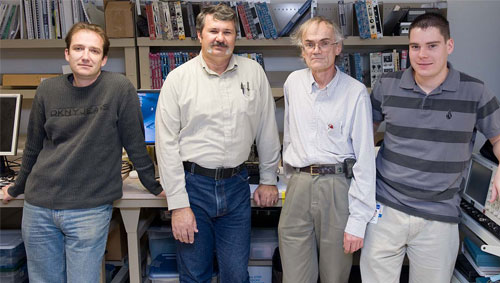 Left to right: Sasha Stolin, Brian Kross, Vladimir Popov and John McKisson designed, developed and built a SPECT camera for Johns Hopkins University that will provide researchers with a high-resolution, high-efficiency device for imaging biological functions in small animals. The JHU research will study vulnerable arterial plaque.
Work by several current and former members of JLab's Radiation Detector and Imaging Group has come to fruition now that they have delivered a specialized imaging camera that they designed, developed and built for Johns Hopkins University researchers. A small team of Detector Group members assembled and installed the Single Photon Emission Computed Tomography Camera at the university in November. It will provide JHU researchers with a high-resolution, high-efficiency device for imaging biological functions in small animals. Specifically, the camera was designed to study the basic biology of what is known as vulnerable arterial plaque. Arterial plaque can cause clots that clog arteries in humans and animals, potentially causing a heart attack or stroke. Vulnerable arterial plaque is the plaque that is currently hidden inside the walls of arteries, but has the potential to eventually break loose inside the artery and cause a clot...... more |
|
|
Evtushenko Earns FEL Young Scientist Prize for 2009
|
Helios Heads for Singapore
|
Jefferson Lab Plans "Celebration of Science" Open House for May 1
|
||
|
|
||||
Below the Fold:
|
||||
Detector Group Builds SPECT Camera for
|
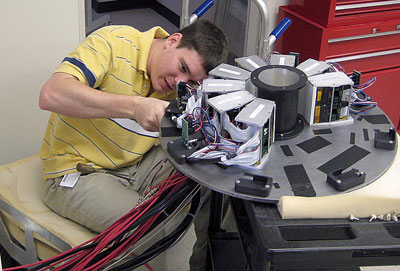 John McKisson, Radiation Detector and Imaging Group member, assembles components for a Single Photon Emission Computed Tomography Camera that the group designed, developed and built for Johns Hopkins University
Work by several current and former members of JLab's Radiation Detector and Imaging Group has come to fruition now that they have delivered a specialized imaging camera that they designed, developed and built for Johns Hopkins University researchers. A small team of Detector Group members assembled and installed the Single Photon Emission Computed Tomography Camera at the university in November. It will provide JHU researchers with a high-resolution, high-efficiency device for imaging biological functions in small animals. Specifically, the camera was designed to study the basic biology of what is known as vulnerable arterial plaque. Arterial plaque can cause clots that clog arteries in humans and animals, potentially causing a heart attack or stroke. Vulnerable arterial plaque is the plaque that is hidden inside the walls of arteries but has the potential to eventually break loose inside the artery and cause a clot. Some research has even suggested that vulnerable arterial plaque may be more important for predicting heart disease and stroke in people than partially clogged arteries, but doctors don't yet fully understand the biology of vulnerable plaque. The camera will provide live-animal physiology imaging for researchers. The camera and research were funded by a National Institutes of Health grant awarded to Johns Hopkins. Detector Group members were excited by the opportunity to develop and build the camera, which provides more cost-effective imaging at a resolution that is comparable to the more expensive PET (positron-emission tomography) scans, according to Drew Weisenberger, Detector Group leader and principal investigator for the camera's development. "This camera could ultimately allow the researchers to do quantitative SPECT imagery," he noted. Most of the work on the device was done over the last 18 months by three Detector Group members: Sasha Stolin, Brian Kross and John McKisson. Development and design of the device began when Stan Majewski was Detector Group leader. Now at West Virginia University, Majewski provided additional assistance, according to Weisenberger. Difference Between PET & SPECT
With PET imaging, a positron is given off by a radiopharmaceutical. When the positron encounters an electron inside the body, the two particles annihilate, producing two photons that may be detected by the PET system. With PET systems, researchers are gathering and tracking second-generation particles: the photons. A SPECT system also images photons, which are given off directly by a radiopharmaceutical, such as Technetium-99. SPECT systems could potentially provide better resolution, since they detect the original particle given off by the radiopharmaceutical.. Also critical to the project's development, but now working for the Radiation Control Department, was Vladimir Popov. He designed, built and tested the photomultiplier electronics used in the device, and he tested all the detectors (photomultiplier tubes) for the first prototypes. He has continued to help with the project. Importantly, Popov developed the matrix decoupling board that is being used in the camera's detector system. The board provides simpler, more cost-effective amplification and conversion of signals for readout. He designed it several years ago and was awarded a patent for it in 2004. His design was the first to achieve resolution down to 1 millimeter, Weisenberger explained. "Vladimir's design also allowed us to combine the photomultiplier tube outputs, reducing the number of cables from 256 to 32. This was a very practical benefit, allowing us to combine the detectors' electronic signals," Weisenberger added. This is also the first time the Detector Group built an imaging device with fiber-optic light guides connected to fine arrays of cesium-iodide scintillators. Stolin was the lead detector physicist for the project. He and John McKisson assembled all the detector elements (the PSPMTs or position-sensitive photomultiplier tubes, and the electronics and scintillators) and developed the sophisticated computer-controlled data acquisition system for the camera. And Kross was in charge of mechanical design and construction. The three put the device together and installed it. Due to funding limitations, the current version of the camera includes eight sensor modules; the design is for 11 modules. The camera was built so that it can be completed with further funding, according to Weisenberger. The mounting system will also allow for a second configuration that would hold a total of 15 modules at a larger diameter to accommodate larger small animals. In addition to conducting the research, JHU is developing the gantry and the mounting plate for the system. |
Evtushenko Earns FEL Young Scientist Prize for 2009 |
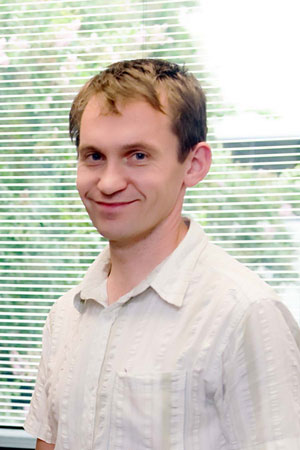 Free-Electron Laser staff scientist Pavel Evtushenko was awarded the FEL Young Scientist Prize for 2009 at the 31st International Free Electron Laser Conference held in England last August.
During his last two years of master's degree study at Novosibirsk State University, he worked on the development of diagnostic injector of hydrogen atoms and beam measurements for the Tokamak Textor at Juelich, Germany Free-Electron Laser staff scientist Pavel Evtushenko knew two things when he was notified in June that he'd been awarded the FEL Young Scientist Prize for 2009: that he was absolutely thrilled and that he was going to have a heck of a time keeping it a secret for two months. He received the award at the 31st International Free Electron Laser Conference held in Liverpool, England, Aug. 23-28. His journey to this prestigious award (which acknowledged his accomplishments and promise in electron beam diagnostic work and for the work he did on the ELBE injector, the JLab FEL and CEBAF) began in the Russian city of Novosibirsk, home of the Budker Institute of Nuclear Physics. The institute's presence made the nearby Novosibirsk State University one of the best schools at which to study physics, and he was, he said, privileged to go there. He'd known since he was in high school that he would pursue math, chemistry or physics; he was equally adept in all three, but was required to choose before applying to the university. Unlike American schools, Russian universities require a weeklong series of written and verbal tests in a specific subject, as well as an essay. He was, he noted, pleased to be accepted into the physics program, where he specialized in plasma physics. "Physics really combines all of it," he explained. "It's all about understanding how the world works." He received his bachelor's and master's degrees at Novosibirsk State University, finishing in 1998. By the summer of 1999, fate and luck stepped in to send his career in an unexpected direction. One day he was told that a secretary from the Budker Institute of Nuclear Physics, which is closely connected to Novosibirsk State, was looking for him. He tracked her down and her question was succinct: "Would you like to go to Germany to work on your Ph.D.?" A position was open at the Institute for Nuclear and Hadron Physics in Dresden. No Germans had applied for the work with the FEL source, and the deadline for applications was just a week away. At breakneck speed, and facing the challenge of translating documents and forms, Evtushenko made the deadline and was accepted. "I knew I was extremely lucky," he said with a smile. "It was like winning the lottery." Although it took nearly another year for his clearance to go to Germany, the wait was worth it. "It was the beginning for me of a new and different life," he said. It was in Germany that his attention was turned toward electron beam diagnostic development as he worked on the ELBE project. He remembers the commissioning date easily and with mixed emotions. "We had a huge celebration for the opening of the facility," he recalled, "and we were all so happy. But it was September 11, 2001, and when we found out what had happened in the United States our spirits were dampened." Evtushenko had a particular affinity for the U.S. since he had been at Jefferson Lab for three weeks in 2000 at the invitation of George Neil, current head of JLab's FEL program. He received his Ph.D. in accelerator physics in October 2004 from the Technical University of Dresden, based on his ELBE work. He married his wife, Nadezhda, in December of that year. By then he had attended many FEL conferences, his work was becoming known and he contacted Neil, to see if there was a possibility of coming to JLab. He arrived in March 2005. In addition to his work in the FEL Division, he supervises a Ph.D. student from Old Dominion University. He and Nadezhda live in Yorktown. She has a master's degree from Old Dominion University in economics and works as a research assistant in Richmond. In his free time, Evtushenko pursues his passion for rock climbing and running. And finally, after receiving his Young Scientist Prize at the International Free Electron Laser Conference last summer, he was free to share his secret. "It was very, very exciting," he recalled. "I'm particularly proud to represent Jefferson Lab since this is only the third time the Young Scientist Prize has been given. This is an international award, and as a relatively small lab, it is harder for us to compete. I'm looking forward to the work ahead." By Judi Tull |
Helios Heads for Singapore |
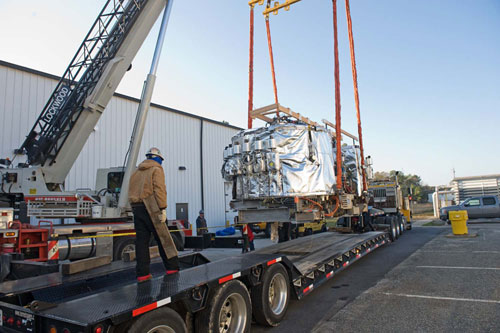 A contractor monitors the pallet holding Helios 1 as it is being lifted by a 70-ton crane and loaded onto a flatbed tractor-trailer as it begins its trip to Singapore. The loading procedure took place Dec. 21. Helios 1 includes the 57,000 pound storage ring and three transportainers of support parts and equipment.
Helios 1, a compact superconducting electron accelerator and storage ring kept at JLab for several years, is on its way to join Helios 2 at the Singapore Synchrotron Light Source located at the National University of Singapore. The journey that is taking the 57,000 pound system halfway around the world began on Dec. 21 under the guidance of property managers Tom Briggs and Joan Campbell. Even though the machine never ran at JLab, it benefited the laboratory and Louisiana State University before it was transferred to SSLS. A number of ion pumps, vacuum valves and some lead and borated polyethylene shielding on Helios were removed and installed in JLab's Free-Electron Laser, and parts of Helios' two 100 MeV linear accelerator sections are now part of LSU's Center for Advanced Microstructures and Devices. Helios 1 was designed in the late 1980s and was initially used by private industry as a possible manufacturing tool for making microchips. "When excimer laser technology became cheaper and more readily available, industry changed directions," explains Gwyn Williams, FEL Basic Research program manager. "In 2000, private industry donated Helios 1 to JLab. Proposed programs for using Helios in conjunction with the FEL didn't materialize, so the system went unused for many years." The SSLS at the National University of Singapore, a project initiated in the 1990s was originally aimed at X-ray proximity lithography for semiconductor manufacturing. But the program branched into additional areas of research after the accelerator system was installed at the SSLS in 2000. The SSLS uses the compact superconducting electron storage ring Helios-2, built by Oxford Instruments, as its source of synchrotron radiation. The scope of applications extends from micro/nanofabrication and technology to the characterization of materials and processes by synchrotron radiation. SSLS researchers are also working on the development of superconducting miniundulators as key components of future synchrotron light sources. Williams anticipates that Helios 1 will be used for spare parts and to support the Helios 2 research program at SSLS, although operating Helios 1 as a light source has not been ruled out. LSU is a member of the Southeastern Universities Research Association – a Jefferson Science Associates partner. It's Center for Advanced Microstructures and Devices is a synchrotron radiation research center in Baton Rouge. The facility provides infrastructure for research and education in synchrotron-based science and technology. It was built with a $25-million grant from the U.S. Department of Energy and is currently operating with an annual state-provided budget of $4 million. The heart of the facility is a 1.5 GeV electron storage ring that was built exclusively to provide synchrotron radiation. Research in basic sciences and microfabrication is conducted by scientists and engineers from Louisiana universities, along with scientists from national and international institutions. |
Jefferson Lab Plans ‘Celebration of Science’
|
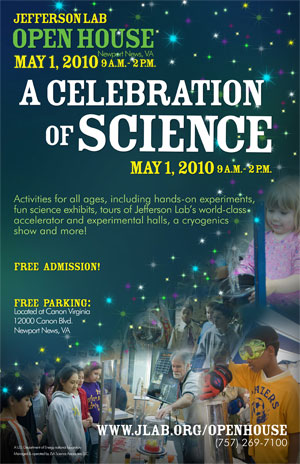 Open House Poster
Jefferson Lab is planning a public Open House for Saturday, May 1. Save the date and plan to spend the day at the 2010 Open House, A Celebration of Science. The event will feature a variety of hands-on, science-education activities for the young and young-at-heart. Visitors will be able to enter portions of the lab, learn about the $310 million 12 GeV Upgrade project underway that will allow JLab to continue as a world leader in scientific research, and to learn first-hand from staff and users about research underway at the lab. Local universities, museums, private companies and government agencies will present activities and information on complimentary local science endeavors including the Hampton University Proton Therapy Institute, The Mariners' Museum, The National Oceanic and Atmospheric Association and the Newport News Fire Department. This year, Open House will be featured as a National Lab Day event. National Lab Day is a federally endorsed, national campaign to foster hands-on learning in science and math. To learn more about National Lab Day, visit: http://www.nationallabday.org . The Open House is free of charge and will be held rain or shine. Free parking will be at the Canon Virginia parking lot located at 12,000 Canon Boulevard, in the Oyster Point area of Newport News, Va. Large charter buses will transport visitors, for free, between the Canon parking lot and Jefferson Lab (about a 3-minute bus ride) from 9 a.m. - 2 p.m. The last bus bringing visitors to Jefferson Lab will depart the Canon parking lot promptly at 2 p.m. From 2-4 p.m. the shuttle buses will only return visitors to the Canon parking lot. Handicap and group parking will be available at Jefferson Lab. For additional information and instructions for off-site parking at Canon Virginia, please check the Open House webpage at: http://www.jlab.org/openhouse/ after Feb. 1. Jefferson Lab's last Open House was in April 2007. |
2010 Science Bowl Season is Here; High School Event is Feb. 27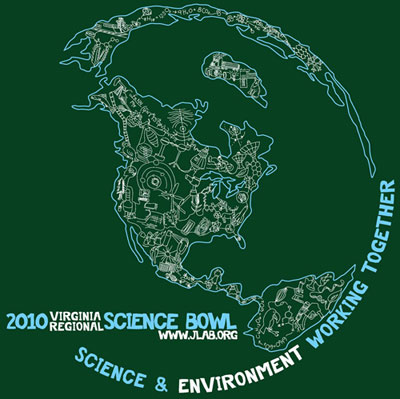 2010 Science Bowl T-Shirt design.
- Please note Sat., Feb. 27, is the new Date - The 2010 National Science Bowl season is here, and Jefferson Lab's Science Education team is seeking volunteers to help with the two tournaments being held here in February and March. The National Science Bowl competition, sponsored annually by the U.S. Department of Energy since 1991, is a highly visible series of academic competitions among teams of students. "DOE is celebrating its 20th year of sponsoring the Science Bowl program. These events champion an interest in science, math and technology," says Jan Tyler, Science Education manager, "and are a great way to promote education, academic excellence and careers using math and science." Volunteer support is critical to the success of both events being hosted by Jefferson Lab: the Virginia Regional High School Science Bowl on Saturday, Feb. 27, and the Virginia Regional Middle School Science Bowl set for Saturday, March 6. "We need just a few more volunteers for the Feb. 27 tournament. We are also recruiting volunteers for the March 6 tournament. We will need volunteers for a range of activities for March 6," she adds. "These events are great fun. We provide all volunteers with training and a chance to practice, a Science Bowl T-shirt, and lunch if you work morning and afternoon. We need you, your co-workers, spouse and children (over age 13) to assist with the many activities required to conduct these academic competitions. "We need new and former volunteers. If you have volunteered for prior Science Bowls, or if you've never been to a Science Bowl, but want to be part of the excitement, we want you, especially for the March 6 tournament" she continues. More than 70 volunteers are needed to run each of the Science Bowls. Most of the volunteers perform as competition moderators, rules judges, timekeepers and scorekeepers during the morning, round-robin sessions, according to Tyler. She also needs a smaller number of volunteers to run the afternoon double-elimination matches, be the on-site scientific judge who is called when a student challenges a question or answer during the competition, and a few individuals to help with administrative tasks and the afternoon Stay All Day Contest held in the VARC classrooms. Most of the public areas and conference rooms of CEBAF Center will be taken over during each of the competition days. Twenty teams – that's more than 200 high school students, their families and coaches – will gather for the high school bowl. And a record 27 teams have registered for the middle school tournament. The top three teams of each event will earn cash prizes for their respective schools. The top high school and middle school teams will also win expenses-paid trips to the Science Bowl Nationals April 29 to May 4 in Washington, D.C. Each team is made up of four or five students, and a teacher who serves as advisor and coach. A Science Bowl is an academic competition among teams of students who compete in a verbal forum to solve technical problems and answer questions in all branches of science and math. The regional and national events encourage student involvement and interest in math and science activities, improve awareness of career options in science and technology, and provide an avenue of enrichment and reward for academic science achievement, according to Tyler. Teams that don't advance to the afternoon finals rounds are invited to stay and compete in a series of design and engineering challenges dubbed the Stay All Day Contest. Teams are presented with three different activities where they have to analyze problems, develop working prototypes with specific materials and make projections based on a model's performance. The team with the best combined results for the activities wins. Helping with the Science Bowls is strictly a volunteer activity, Tyler reminds aspiring helpers. Anyone interested in more information or in volunteering, may contact Tyler by email (tyler@jlab.org). Volunteers may sign up for the morning shift (8:30 a.m. to 1 p.m.) or for the day (9 a.m. to 3 p.m.). High School Science Bowl Practice Sessions Lasers Used to Make First Boron-Nitride Nanotube YarnResearchers have used lasers to create the first practical macroscopic yarns from boron nitride fibers, opening the door for an array of applications, from radiation-shielded spacecraft to stronger body armor, according to a new study. Researchers at Jefferson Lab, NASA's Langley Research Center and the National Institute of Aerospace created a new technique to synthesize high-quality boron-nitride nanotubes (BNNTs) using Jefferson Lab's Free-Electron Laser. They then used a commercial laser to produce masses of BNNTs that are about 100 times longer than typical nanotubes of this type, while still retaining the highly crystalline, small diameter and few-walled characteristics that researchers aim for. For the story, visit this link: lasers-used-make-first-boron-nitride-nanotube-yarn Technology and Engineering Development Facility Project to Change LandscapeA $73-million project to construct a new engineering and technology facility and modernize another facility at Jefferson Lab is now in the final design phase. The Technology and Engineering Development Facility project will not only provide state-of-the-art facilities for research, it will also change the face of the laboratory complex. TEDF will provide state-of-the-art facilities for research in the areas of nuclear physics, accelerator science, applied nuclear science and technology, and advanced superconducting radiofrequency instrumentation. The project reached a critical milestone on Nov. 12, when the U.S. Department of Energy gave approval to the project’s performance baseline. The approval, known as Critical Decision 2 or CD-2, authorizes the final design phase to begin. Once complete, the TEDF will provide a 70,000-square-foot Technology and Engineering Development building, a 30,000-square-foot addition to the existing Test Lab building and will modernize the 96,000-square-foot Test Lab (Building 58). Plants Studied with New PET ScannersPET scans have been used for decades to help doctors diagnose disease in people – from cancers to heart problems. Now, the technology is returning to one of its early roots: the study of plants. The work is supported by the Department of Energy's Office of Biological and Environmental Research. It is featured in BER's portfolio of basic ecological research to understand how rising amounts of carbon dioxide, or CO2, in the atmosphere will affect the environment. Previous research has found that plants grow more vigorously if exposed to additional carbon dioxide, at least up to a point. Now scientists want to know what factors limit plants' ability to use additional CO2, how plants pass on additional CO2 to bacteria in the soil (carbon sequestration), and in what ways potential biofuel-producing plants can be optimized to take advantage of additional CO2 in the atmosphere. Jefferson Lab's Radiation Detector and Imaging group, in collaboration with Duke University, has started work on developing specialized plant imaging systems, funded by a Scientific Focus Area grant from BER. The grant provides $600,000 each year for three years, beginning with the new fiscal year that began Oct. 1. The project has already taken root with two preliminary studies completed so far. More about this story is available at: Seeing_Green Women's Issues in Science and Engineering Take Center Stage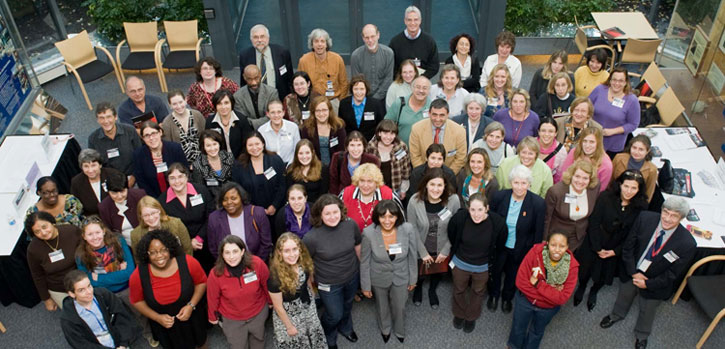 Those attending the Women in Science and Engineering Workshop held at Jefferson Lab on Nov. 16 paused for a group photo
Women and men from around the world converged on Jefferson Lab Nov. 16 for the Women in Science and Engineering Workshop. Attendees from a broad array of careers participated, from physicists and engineers to computer scientists and administrators. In all, more than 120 people came together to talk about the challenges faced by women in the science and engineering disciplines. Jefferson Lab Director Hugh Montgomery kicked off the workshop and also fielded, arguably, one of the more interesting questions of the day. One attendee wanted to know if he'd be present for the full workshop or if he was planning to leave early. Montgomery pulled out his pocket calendar and noted that he had two other meetings, both during workshop breaks. The challenge to workshop participants was summed up in a quote attributed to Meg Urry, a Yale physics professor, that was issued by Latifa Elouadrhiri, a JLab staff scientist and workshop organizer: "Change is within reach, but it requires action." Elouadrhiri also explained the impetus behind the workshop, organized by the Committee on Women in Physics and Engineers at Jefferson Lab. The ad-hoc committee seeks to increase participation of women in physics and engineering in general and at Jefferson Lab, in particular, by encouraging more girls and women to enter these fields and by supporting women already in the field at Jefferson Lab. According to Elouadrhiri, the purpose of the workshop was education. The committee wanted to learn about best practices at other institutions and seek advice from experts, which included not only the speakers but all workshop attendees. Eventually, the committee hopes that the knowledge shared at the workshop will lead to steps that will increase the number of women in science and engineering as a whole. In particular, the committee sought to encourage immediate action at JLab, in hopes that it would spread to the lab's user institutions, workshop participants' institutions and beyond. Workshop participants were presented with a wealth of data regarding women's participation in the Science, Technology, Engineering and Mathematics fields. The three most-cited reports were the 2007 APS Gender Equity Conference, Broadening Participation at the National Science Foundation: A Framework for Action, and Gender Differences at Critical Transitions in the Careers of Science, Engineering, and Mathematics Faculty. These reports offer hard data on gender differences in the STEM fields, as well as recommendations on steps that institutions and individuals can take to increase women's participation in STEM fields. In addition to the bounty of hard data, there were also many anecdotes. Listed under "egregious remarks" were those from The Dual-Career-Couple Survey of physicists beset by the so-called two-body problem, where a physicist and a highly educated partner were both looking for employment. The two-body survey was conducted in 1998. There were 620 respondents, and many took the time to write in comments concerning finding employment for a dual-career couple, which included: One professor suggested to my husband at his interview that one way to solve the two-body problem was to divorce me; told candidate that spouse shouldn’t be working anyway; and if women in physics want jobs, they shouldn’t marry scientists. Perhaps the most surprising revelation for those new to the gender equity arena is that those perpetuating the problem may not even realize it. One study presented by Kathleen McCloud, a program officer at the National Science Foundation, showed bias in committees that select musicians for orchestras. When the judges could not see the auditioning musicians, the percentage of female new hires increased 25-46 percent. Another study showed a clear effect that the name listed on a resume had on the likelihood of a job hunter getting a callback for an interview. More on implicit bias can be found at the Project Implicit website. Following this day of data, anecdotes and action plans, came a day of meetings organized by the Committee of Women in Physics and Engineers at Jefferson Lab, to discuss how JLab could meet the committee’s goal. As for Jefferson Lab's director, he did attend every session – which meant he must have been a little late for his other meetings. The workshop was supported by the JSA Initiatives Fund, a $500,000 program provided annually by Jefferson Sciences Associates, LLC The Story of 6 GeV at CEBAF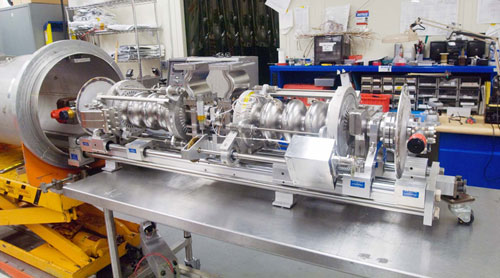 This photo shows a reprocessed cavity pair before assembly into a helium vessel to form a cryounit (one-quarter of a cryomodule).
With the spotlight on the CEBAF accelerator's upgrade for future nuclear physics experiments at 12 GeV, it's easy to overlook something important that's being realized as of mid-2009: CEBAF's evolution into a machine that can operate reliably at 6 GeV – 50 percent higher than the 4 GeV energy that was promised when construction began more than two decades ago. The achievement of routine, stable 6 GeV running is fundamentally important for the laboratory. Not only does the higher energy enable users to probe the nucleus more accurately, but it's crucial for reaching 12 GeV. The upgrade is predicated on starting with a 6 GeV machine. The achievement is also an interesting story. It goes back more than a quarter of a century. First Goal Was 4 GeV Physicists struggle to decide how much energy a planned accelerator must deliver. What will it take, and at what cost to conduct the needed investigations? Those are difficult questions to answer, especially since the scientific territory to be investigated is by definition unknown. What was known when CEBAF was first considered was that to achieve the precision capability needed for the anticipated physics program, the beam on target needed to be continuous, rather than pulsed. Originally, a 2 GeV beam was the goal for CEBAF, but by 1985 the accelerator design had been changed to a 4 GeV machine. This 4 GeV CEBAF wasn't planned as the superconducting radiofrequency (SRF) machine that exists today. It was to have been a linear accelerator built with conventional "room-temperature" technology. To attain the "continuous" characteristic required for physics, this conventional accelerator was to work in combination with something called a pulse stretcher ring. But by early 1986, the potential advantages of the SRF approach led to its adoption, setting the 4 GeV CEBAF on a path to become the first large-scale application of what was then a brand-new technology. It was a cautious path. Even today SRF offers plenty of surprises, challenges and unknowns. That's part of why Jefferson Lab's SRF experience and expertise are so valued for other accelerator projects around the world – and it's part of why 6 GeV is a real achievement. So in the late 1980s, when the accelerator still existed only in its builders' imaginations, there was plenty of reason to be scrupulously careful about putting SRF into action in this new research tool, anticipated by both nuclear physicists and the Department of Energy. The physicists and engineers designing CEBAF worked conservatively, striving to make sure that even if the finished machine didn't do everything exactly right, it would still meet its basic performance specifications – including 4 GeV. Yet even amid the purposeful cautiousness, they also looked far ahead. They foresaw the need for future improvements, like the evolution to 6 GeV and future upgrades. One of the clearest examples of that foresight was the switch to SRF. First, though, the lab’s founders had to deliver and operate a reliable 4 GeV machine. The key capability, but by no means the only element, in reaching 4 GeV was accelerating gradient, which is simply the accelerator's ability to boost electrons' energy by a given amount within a given distance. The SRF accelerating cavities have to work as part of an enormously complex operation involving not only the cryomodules that contain them, but: When the accelerator was new (and still today) this complexity meant that those who operated CEBAF had to learn, first, what effects limited the accelerator's performance, and second, how to overcome those effects. Eventually, the accelerator became capable of operating reliably at 5.2 GeV, substantially more than originally promised. Toward 6 GeV Even then, CEBAF's scientific users looked forward to still higher energy. Standing in the way, however, was the arc trip rate. On SRF cavity insulators, a static electric charge builds up during operation. When it eventually arcs or discharges to the cavity itself, the arc causes the cavity automatically to trip off, something like when a switch shuts off a lamp. Each arc trip means losing a few or many seconds while the cavity is restored to service. If the rate at which these arc trips occur is too high, say, 15 or more per hour distributed over the 320-plus cavities in the accelerator, the accelerator isn't doing its job well enough for users trying to conduct experiments. Get it down to eight or so per hour, and you have smooth sailing. Each cryomodule has its own trip rate. It was, and still is, vital to determine just how to manage all of the cryomodules around the accelerator to get the most from each cavity while maintaining an acceptable overall arc trip rate. That determination gets made using sophisticated statistical methods that incorporate performance data from each cavity and cryomodule. The first efforts toward 6 GeV actually began almost a decade ago. But even with the continually improving understanding of the technical choreography involved in operating CEBAF, it was clear that some higher-performing cavities and cryomodules would be required. 'C50' Cryomodule Refurbishment By 2003, it had become possible to run CEBAF at 5.7 GeV. In September of that year, however, Hurricane Isabel blew into town. Its damage included loss of electrical power to the Central Helium Liquefier, which maintains the cavities inside the cryomodules at their operating temperature of 2 Kelvin, not far from absolute zero. When the CHL lost electrical power, the cryomodules and the SRF cavities inside them warmed up. It was an uncontrolled – and definitely undesired – warmup. SRF cavities are delicate devices, requiring meticulous preparation and care. The uncontrolled warmup caused harm. This added significantly to a reduction in performance that had started accumulating gradually over years of intense use. During the years leading up to 2003, though, JLab's SRF scientists, engineers and technicians had learned more and more about the delicate processing of SRF cavities. For example, they had become better able to make cavities ultra-clean before installing them in cryomodules. This improves cavity performance. So, a formal cryomodule refurbishment program called "C50" began, with the purpose of increasing the accelerator's energy and reliability. The program was called "C50" because the idea was to refurbish 10 cryomodules to make each of them capable of yielding 50 megavolts of acceleration, approximately doubling the original performance. Weaker-performing cryomodules would be removed from the tunnel, reworked using improved processes, and then re-installed as strongly performing cryomodules. Refurbishment was scheduled at three cryomodules per year. The first C50 goal was to reach 5.75 GeV quickly, but without sacrificing quality. The second was to maintain that energy while continuing to improve the hardware needed to reach 6 GeV. Top priority has been to maximize CEBAF's availability for physics users and, in fact, during 2008 users completed 15 experiments. The first C50 cryomodule operated in the accelerator in February 2007, leading to 5.1 GeV (less than the 5.2 GeV previously achieved, but even the weak modules removed to begin the refurbishment process had been making some contribution) by June. By October 2008, with six C50 cryomodules re-installed and commissioned, CEBAF had reached 5.9 GeV, but with an arc trip rate worse than 15 per hour. By December, the rate was down to just below 15 per hour. By January 2009, due to statistical analysis for optimizing accelerator operation, it was down to below 10 per hour – relatively smooth sailing. And then on June 15 and 16, CEBAF reached 6.068 GeV, delivering beam at 100 microamperes of current to Hall A. The trip rate was almost 15 per hour, but typically the trip rate starts out high and improves with fine tuning. This test demonstrated that Jefferson Lab does indeed now have a full 6 GeV "beam loaded" CEBAF accelerator. Looking ahead Not everything about the achievement of 6 GeV has been perfect. The refurbished cryomodules haven't seen the expected improvement in the quality factor Q, a key accelerator performance measure. But with the eighth C50 cryomodule re-installed and commissioned as of April 2009, the ninth C50 re-installed in late summer 2009 and commissioned over the fall, CEBAF successfully completed a two month physics run at 6.068 GeV in November and December 2009. With the tenth C50 installed and commissioned during the 2010 winter accelerator down, the focus is on making 6 GeV operation even more routine, reliable, and robust. The lab itself was called CEBAF until Thomas Jefferson's name was adopted in 1996. During the 1980s, CEBAF's staff made a 4 GeV promise to nuclear physics users, to the Department of Energy, and to the taxpayers who ultimately pay the bills. Not only has that promise been realized, but it's now being enlarged upon substantially. Now the achievement of 6 GeV places Jefferson Lab in position to carry out another big promise: to double the energy via the 12 GeV upgrade, thereby greatly multiplying CEBAF's usefulness for science. Highlights From Jefferson Lab's 25th Anniversary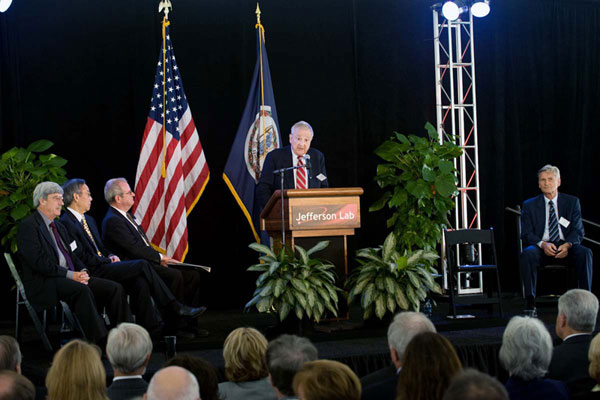 Highlights from Jefferson Lab's 25th Anniversary celebration, held on Sept. 29, 2009, are posted on the lab's 25th Anniversary webpage at: http://www.jlab.org/25years/ . The web link provides access to stories, media coverage, a digital photo album, a video recording and the text of the speech given by one of the keynote speakers (J. Dirk Walecka, JLab's first scientific director and Governor’s Distinguished CEBAF Professor of Physics, emeritus, with the College of William and Mary).
Property Custodians Are Responsible for Use, Protection, Disposition of Items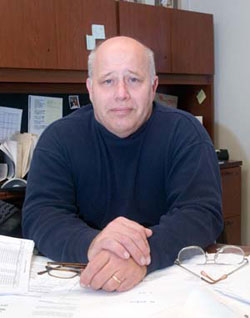 Tom Briggs, JLab Property Manager
Nearly every employee at JLab is a property custodian. A property custodian is responsible for the proper use, control, physical protection and disposition of his or her assigned property – be it one item or 100. For more information about the proper management and disposal of JLab property, refer to the Property Manual, which is accessible from the Property webpage. This Property Management and Disposal and Recycling quick reference card is also useful to keep handy. In advance of the annual property validation process, scheduled to begin in March, Tom Briggs, JLab property manager, offers the following advice: Tom's Guidelines for Better Property Management Tool Crib is Open: Borrow Items Instead of Buying Them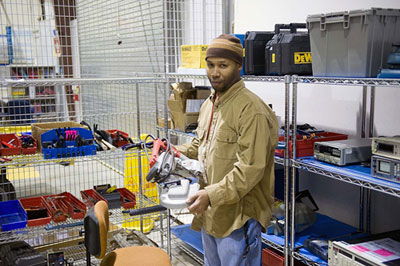 Lawrence Ferbee, Jr., tool crib manager, shows off the variety of tools and devices that can be signed out from the tool crib for use in carrying out JLab work.
In an effort to make certain types of tools and equipment more readily available to staff and users conducting JLab work, a tool crib has been created. "As you plan your work, if you don't have the right item to do a job, check the tool crib before ordering that new tool or piece of equipment," says Lawrence Ferbee, Jr., tool crib manager. "A tool crib is great because it can reduce the amount of money your work group spends on tools or specialized equipment – especially items that you use infrequently. It also reduces the number of tools that you (as a property custodian) need to manage and the space required to store them," Ferbee adds. "The tool crib has items to support simple jobs as well as some specialized tasks." The JLab Tool Crib is located in a locked cage area adjacent to the Stockroom and Free Stock in Building 90, the Experimental Equipment Lab, and has hundreds of items on hand for loan. It includes items ranging from hammers, screwdrivers and flashlights to soldering stations, portable band saws, oscilloscopes and pulse generators, and even ready-to-go tool kits that include a standard socket set, a pliers set, a 25-foot tape measure and a plastic micrometer. Tools may be signed out for as little as one day or for as long as six months, and must be used for JLab work. JLab computer account holders that have access to db3 (accessible through PuTTY) can pull up a current inventory of the tools and equipment available for sign out. Open PuTTY and select or type in "db3". Then log on with your user name and password. At the db3> prompt, type in "toolcrib" and press the "Enter" key, then select "b" (update/browse assets), then "d" for the equipment pool item list. If you don't have, but would like access to the tool crib database on db3, contact Ferbee.
After finding the item(s) you need in the inventory listing or to browse the shelves, contact Ferbee, ext. 6297 or email ferbee@jlab.org, to set up a time to meet him at the tool crib. There you will sign the paperwork and pick up the item(s). Users are asked to have their JLab sponsor make their loan requests. Contact Ferbee to access the crib Monday through Friday, 7 a.m. to 4 p.m. "We started setting up the tool crib in 2007," Ferbee notes. "A few work groups donated tools and equipment that they weren't fully using, making those items available for others to sign out on an as-needed basis." He asks all workers and work groups to look over their tools and equipment. "If you have items that you seldom or never use, please donate them to the tool crib. I can even accept some types of items that may need repair," Ferbee adds. More items enter the tool crib inventory on a regular basis; so check the inventory regularly. "Don't spend money if you don't have to. If we have what you need in the tool crib, sign it out, use it and return it," Ferbee says. Free Stock Offers Materials, Furniture Available For JLab UseCheck out Free Stock before you order supplies or materials for that small JLab job, or if you run short during a bigger job. Free Stock is located adjacent to the Stockroom in Building 90, the Experimental Equipment Lab. The Free Stock inventory currently includes wiring, cabling, switches (resistors, connectors and other electronic items), fasteners (nuts, bolts and washers), and some general office supplies and office furniture. The items in Free Stock are left over from various JLab work activities and projects, and are available at no cost to the person or work group that can use them. With nearly 850 different types of items currently available in Free Stock, what you need just might be there, according to Lawrence Ferbee, Jr., Free Stock clerk. The next time you visit the Stockroom or the Tool Crib, stop by Free Stock to see what is available, he says. These materials and supplies must be used to conduct JLab work. For more information contact Ferbee, ext. 6297 or email ferbee@jlab.org. Likewise, individuals and work groups may submit usable or reusable, excess or leftover materials to Free Stock. Say you've finished a job, moved your office, or cleaned out a storage cabinet and have usable quantities of materials or supplies you have no further use for – not trash, but stuff others can use – give them to Free Stock, Ferbee. "It's a great way to use up leftover materials and supplies that JLab has already paid for. After all, one person's junk can be another's treasure." Individuals with purchase accounts may access the list of Free Stock items; visit webstock at https://misportal.jlab.org/punchout/index.jsf. Once on the main webstock page, click on the "Adv Search" button (lower right of screen). A small screen will pop up that lists the acronym for all the vendors. Unselect all, then select only FREESTK (green check mark √). In the blank "Keyword" block at the top of the screen, type in keywords describing the item you are looking for. Then click on the "Search" button. The Free Stock online catalogue also includes digital photos of available office furniture. Chemistry Demos Set to Pop Music at JLab on Feb. 9Jefferson Lab's Feb. 9 Science Series event will feature members of the Tidewater Alliance of Chemistry Teachers (TACT) presenting 11 elaborate chemical demonstrations that have been choreographed and set to popular music. The program, titled A TACT-ful Chemical Musical, also incorporates some audience participation. The Tidewater Alliance of Chemistry Teachers, established in the late 1970s, is a local professional organization dedicated to promoting excellence in chemical education through programs for and networking between high school, community college and university chemistry educators in Hampton Roads and across North America. The Feb. 9 event will start at 7 p.m., last about an hour and include a question-and-answer period at the end. It will take place in Jefferson Lab's CEBAF Center auditorium, located at 12000 Jefferson Ave., Newport News. It is free and open to anyone interested in learning more about science. For security purposes, enter at Jefferson Lab's main entrance (Onnes Drive.). Everyone over 16 is asked to carry a valid photo ID. Security guards may perform ID, parcel and vehicle checks. For directions and information about other Jefferson Lab public lectures, visit http://education.jlab.org/scienceseries/index.php, or contact Christine Wheeler, email wheelerc@jlab.org or call 757-269-7560. This lecture is part of Jefferson Lab's ongoing fall and spring Science Series. Milestones: January 2010Hello Charles Doty, 12 GeV Accelerator Work Coordinator, 12 GeV Upgrade Project State employees at JLab recently hired by JSA/JLab: Goodbye Linda Even, Environmental Engineer, Environment, Safety, Health & Quality Division These Milestone entries, listed alphabetically, are full-time, term, casual and student actions posted by Human Resources for January 2010. Jefferson Lab is currently seeking several qualified individuals for a range of engineering positions. More than 30 JLab career opportunities are posted at: https://careers.peopleclick.com/careerscp/client_jeffersonlab/external/search.do For more information about employment at JLab, visit: http://www.jlab.org/div_dept/admin/HR/index.html |
|
The On Target newsletter is published monthly by the Thomas Jefferson National Accelerator Facility (Jefferson Lab), a nuclear physics research laboratory in Newport News, Virginia, operated by Jefferson Science Associates, LLC, for the U.S. Department of Energy's Office of Science. Possible news items and ideas for future stories may be emailed to jlabinfo@jlab.org, or sent to the Jefferson Lab Public Affairs Office, Suite 15, 12000 Jefferson Avenue, Newport News, VA 23606
|


 Free-Electron Laser staff scientist Pavel Evtushenko knew two things when he was notified in June that he'd been awarded the FEL Young Scientist Prize for 2009: that he was absolutely thrilled and that he was going to have a heck of a time keeping it a secret for two months....
Free-Electron Laser staff scientist Pavel Evtushenko knew two things when he was notified in June that he'd been awarded the FEL Young Scientist Prize for 2009: that he was absolutely thrilled and that he was going to have a heck of a time keeping it a secret for two months.... Helios 1, a compact superconducting electron accelerator and storage ring kept at JLab for several years, is on its way to join Helios 2 at the Singapore Synchrotron Light Source located at the National University of Singapore..........
Helios 1, a compact superconducting electron accelerator and storage ring kept at JLab for several years, is on its way to join Helios 2 at the Singapore Synchrotron Light Source located at the National University of Singapore.......... Jefferson Lab is planning a public Open House for Saturday, May 1. Save the date and plan to spend the day at the 2010 Open House, A Celebration of Science......
Jefferson Lab is planning a public Open House for Saturday, May 1. Save the date and plan to spend the day at the 2010 Open House, A Celebration of Science......